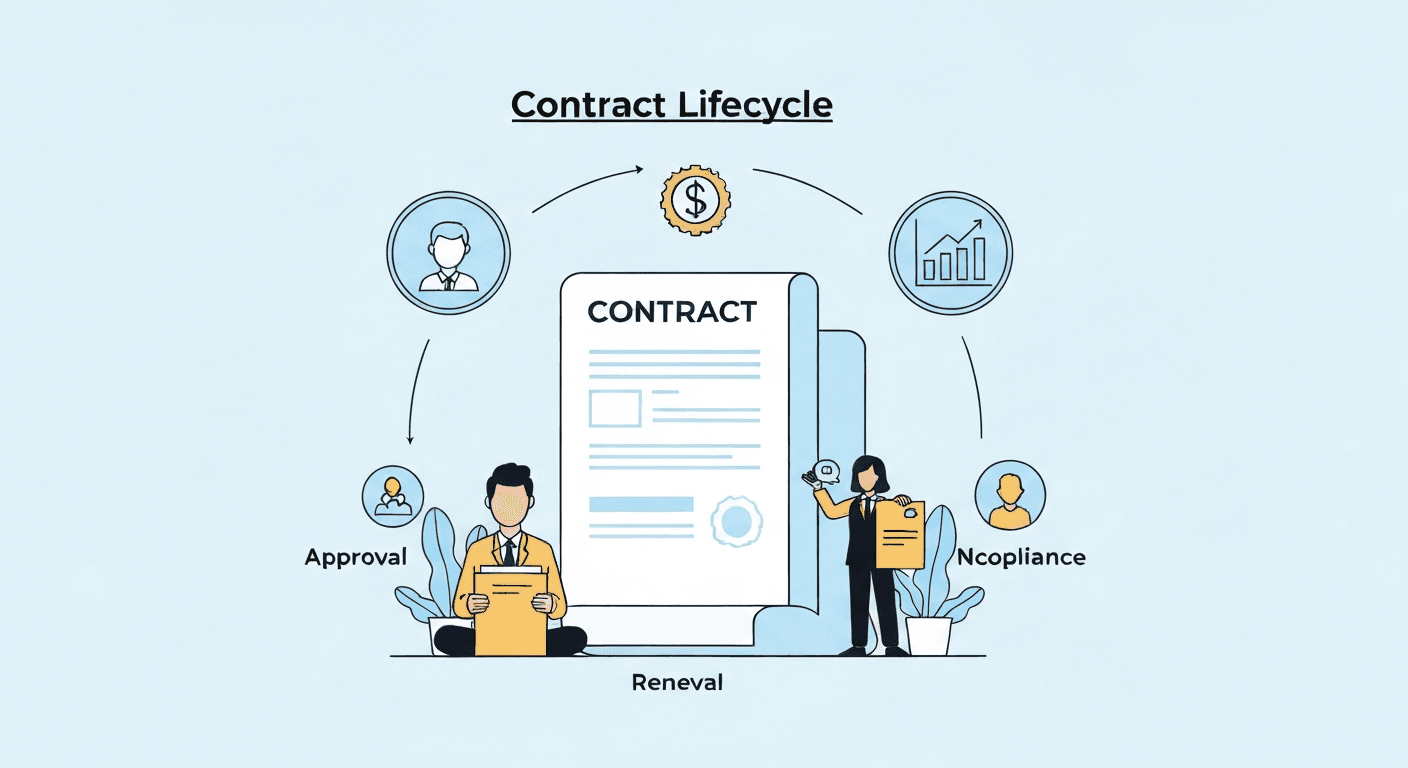Krunal Shah
Nov 22, 2024
Negotiating contracts can be tricky. Contracts often go back and forth between different parties several times before they're finalized. This process is called contract redlining. It's important to make sure everyone is happy with the agreement. But if it's not done right, your organization could lose contracts or face legal trouble. Here's what you need to know about contract redlining, how to do it well, and how to manage it smoothly.
"Contract redlining" is like editing a document together, but for business contracts. When negotiating a deal, both parties suggest changes to the contract terms. These changes are often marked in red (hence "redlining"). It's a way for each side to protect their interests and agree on fair terms before signing.
What does Redlining a Contract mean?

"Redlining a contract" involves reviewing and marking up a contract with proposed changes or revisions, often using red ink or digital tools. This process is crucial in contract negotiations, allowing parties to suggest amendments to better align with their interests. Understanding how to redline contracts effectively ensures that all parties are satisfied and that the final agreement reflects their needs.
What steps can businesses take to prevent and address contract redlining in their contractual agreements?

Contract redlining, where parties mark up contracts with changes they'd like to see, can sometimes lead to delays, misunderstandings, or disputes if not managed properly. Here are steps businesses can take to prevent and address contract redlining effectively:
1. Clear Communication: Ensure that all parties involved in contract redlining understand each other's expectations and requirements. Encourage open dialogue to address any misunderstandings promptly. Clearly communicate any concerns or proposed changes to avoid confusion and streamline the negotiation process.
2. Standardization and Preparation: Create and keep standard contract templates for your business deals. These templates should include all the usual terms and conditions. Before you start changing contracts, make sure everyone knows about these templates. They should understand how to use them well. This saves time and work because you already have a basic contract to start with.
3. Training and Guidelines: Provide training to employees involved in contract negotiation on effective negotiation techniques and company policies. Establish clear guidelines for contract redlining, including expectations for timelines, acceptable changes, and escalation procedures for unresolved issues. This ensures consistency and efficiency in the negotiation process.
4. Technology Utilization: Invest in contract management software that facilitates collaboration among team members and tracks changes made during the redlining process. This technology allows for real-time communication, version control, and easy access to contract documents, reducing the risk of errors and ensuring all parties are working with the most current information.
5. Legal Engagement and Documentation: Engage legal counsel early in the contract redlining process to provide guidance on proposed changes, assess legal risks, and ensure compliance with relevant laws and regulations. Document all revisions made during the negotiation, including the rationale behind each change, to provide clarity and accountability. Conduct a final review and approval of the contract before signing to confirm that all parties are in agreement and that the contract reflects the negotiated terms accurately.
Related Article: Contract Negotiation: Proven Strategies for Collaboration
How does automating contract drafting and redlining processes Work?

By automating contract drafting and redlining processes, businesses can significantly streamline negotiations, reduce errors, and improve overall efficiency. Here’s how to achieve this in five key steps:
1. Invest in User-Friendly Contract Management Software
Choosing the right contract management software is crucial. Look for a solution that allows easy customization of templates, efficient version tracking, and management of key clauses. The software should streamline the drafting process and ensure consistency across all contracts, reducing the need for manual updates and extensive redlining.
2. Standardize Contracts and Integrate Redlining Features
Create standardized contract templates to reduce the need for constant re-negotiation of common terms. Combine this with advanced redlining features in your software, allowing for real-time tracking of changes. This fosters seamless collaboration and ensures that everyone involved can easily view and manage revisions, saving time and reducing errors.
3. Leverage AI for Faster Reviews
AI can analyze contract changes quickly, highlighting critical issues or deviations from standard terms. By automating this review process, teams can identify potential risks faster and make informed decisions, ultimately speeding up the negotiation process and reducing manual effort.
4. Set Up Clear Approval Workflows
Implement structured approval workflows to ensure that all contract changes are reviewed and approved by the appropriate stakeholders. This system helps maintain control over the process, ensures compliance with company policies, and prevents unauthorized modifications, improving both security and efficiency in contract management.
5. Provide Training and Analyze Performance Metrics
To fully maximize your contract management system, invest in comprehensive training for all users and provide ongoing support. Additionally, use built-in analytics tools to monitor contract performance, negotiation timelines, and revision trends. Analyzing these metrics helps identify areas for improvement and ensures continuous optimization of the contract management process.
By adopting these five strategies, businesses can automate key contract management processes, reducing errors, improving collaboration, and increasing overall efficiency.
Related Article: Contract Review Checklist: An Effective Guide
Benefits of Contract Redlining Software

1. Enhanced Communication and Accountability
Contract redlining software fosters seamless communication among all stakeholders by centralizing discussions and actions in one platform. This ensures that everyone is on the same page, with targeted comments and task assignments that improve collaboration. The platform creates clear accountability by tracking who made each change, enhancing transparency throughout the negotiation process.
2. Streamlined Revision Process and Reduced Errors
With centralized version control, redlining software eliminates the complexity of managing multiple document versions, minimizing errors and discrepancies. All revisions, comments, and updates are consolidated in one place, making it easier to review and approve changes. This significantly reduces the chances of overlooked details, resulting in more accurate and consistent agreements.
3. Efficient Negotiation and Faster Decision-Making
Redlining software accelerates the negotiation process by enabling real-time tracking of changes, which allows stakeholders to collaborate more efficiently. The software eliminates the need for sending multiple versions of documents, reducing delays and improving decision-making speed. This streamlined workflow helps teams respond quickly to revisions, expediting the overall negotiation cycle.
4. Improved Compliance and Risk Management
Contract redlining software supports compliance by offering customizable templates aligned with legal and regulatory requirements. Automated compliance checks further ensure that contracts meet necessary standards. The software also maintains a comprehensive audit trail of all contract modifications, helping mitigate risks and ensuring that all changes are traceable, enhancing overall contract integrity.
5. Data-Driven Insights and Continuous Improvement
Advanced analytics capabilities within redlining software provide valuable insights into contract performance. By analyzing trends and key metrics, businesses can make more informed decisions, identify inefficiencies, and optimize their contract management processes. This data-driven approach fosters continuous improvement, ensuring that the contracting process evolves to meet changing business needs.
By leveraging these key benefits, contract redlining software not only enhances efficiency but also improves collaboration, compliance, and decision-making, ultimately leading to better-managed contracts and reduced risk.
Related Article: Contract Negotiation: Proven Strategies for Collaboration
Are there any contract redlining tools available for free?
Yes, there are contract redlining tools available for free or with basic functionalities. Examples include Google Docs, Microsoft Word Online, Volody, etc. These tools offer basic editing, collaboration, and electronic signature capabilities. They are suitable for individuals or small businesses with simpler contract management needs.
Common Challenges associated with contract redlining

1. Version Control:
Include clear instructions on how to track changes and manage versions within the document. Specify the preferred method for naming versions and indicate where the latest version can be found.
Example: "All parties involved in the contract redlining process must utilize the 'Track Changes' feature in the document editing software. When saving new versions, use the format 'Contract_Name_Version_Date' to ensure easy identification. The most recent version of the contract will be stored in the shared folder titled 'Current Contracts.'"
2. Collaboration Complexity:
Define roles and responsibilities for each stakeholder involved in the redlining process. Establish communication protocols for providing feedback and resolving conflicts.
Example: "Legal teams are responsible for reviewing contract clauses related to compliance and risk management. Clients should provide input on terms and conditions relevant to their business objectives. Any conflicts or discrepancies in feedback should be addressed through a designated point of contact or during scheduled review meetings."
3. Communication Breakdowns:
Create a section in the contract outlining the preferred communication channels and procedures for submitting revisions or comments. Emphasize the importance of clarity and completeness in all communications.
Example: "All feedback and revisions should be submitted via email using the provided template. Each comment must reference the specific clause or section being addressed and include a proposed revision if applicable. In case of urgent matters or questions, stakeholders can contact the project manager directly during business hours."
4. Time Constraints:
Set clear timelines for each stage of the contract redlining process and communicate them to all parties involved. Specify consequences for missed deadlines and establish a protocol for requesting deadline extensions.
Example: "The initial draft of the contract will be provided to all stakeholders for review within five business days. Feedback must be submitted within seven business days of receiving the draft. Failure to meet deadlines may result in delays in finalizing the contract or additional review cycles."
5. Risk of Errors:
Include guidelines for conducting thorough reviews of the contract to identify and rectify errors. Specify the validation checks or quality assurance measures that will be employed during the redlining process.
Example: "Before finalizing any revisions, all stakeholders are required to conduct a comprehensive review of the entire document to ensure accuracy and completeness. Automated error detection tools will be utilized to identify inconsistencies or missing information. Any errors found should be promptly addressed and documented."
6. Security Concerns:
Outline the security measures in place to protect confidential contract information and specify the procedures for accessing and sharing documents securely.
Example: "All contract documents will be stored in a secure, password-protected folder accessible only to authorized personnel. Sharing of contract-related information via email or other communication channels is strictly prohibited to prevent data breaches. Access to sensitive documents will be logged and monitored regularly to ensure compliance with security protocols."
7. Integration with Existing Systems:
Provide details on how the contract redlining software integrates with other systems or workflows used within the organization. Specify any data mapping or synchronization processes to ensure seamless data flow.
Example: "The contract redlining software is fully integrated with our existing document management platform, allowing for automatic synchronization of contract data and metadata. Changes made to the contract status or terms will be reflected in real-time across all connected systems, eliminating the need for manual data entry or updates."
Contract redlining: Made easy with Volody

Volody's AI-powered Contract Lifecycle Management (CLM) software offers several benefits for contract redlining. By automating the process of tracking changes between versions of the contract, Volody streamlines the contract negotiation process and saves time. Users no longer need to rely on the traditional red pen and manual markup; instead, they can collaborate on a single platofrm in real-time.
Through collaborative editing in a central repository, Volody ensures that all team members have access to the latest version of the contract, following best practices for contract review. This not only speeds up the review process but also reduces the risk of errors and legal consequences.
Volody's AI utilizes natural language processing (NLP) to understand the contract’s terms and suggest appropriate changes, adhering to the best practices of the contracting process. It provides insights into negotiation trends and common sticking points, empowering users to close deals more efficiently. Integrating seamlessly with other tools like MS Word or Microsoft Sharepoint, Volody's CLM software enhances the entire contract management process. Users can review contracts in a single document from the negotiation stage to the final version, rather than juggling multiple physical documents.
Legal professionals benefit from Volody's clean user interface. Instead of spending extra time deciphering handwritten notes or navigating through different versions, they can focus on the collaborative process of editing contracts effectively. Overall, Volody's AI-powered CLM software transforms the contracting process, providing a digital system that improves collaboration, efficiency, and accuracy from start to finish.
Related Article: Overcome Top 5 Contract Management Challenges with Ease
Conclusion: Simplify Contract Redlining for Success
Contract redlining doesn’t have to be a complicated or time-consuming process. With the right tools, clear communication, and standardized practices, businesses can navigate contract negotiations more efficiently and with greater accuracy. Modern software solutions like Volody’s AI-powered CLM make it easier than ever to manage changes, collaborate in real-time, and ensure compliance.
By adopting these strategies, organizations can reduce errors, save time, and create contracts that meet everyone’s needs. Whether you’re a legal professional or a business owner, streamlining the redlining process can help you close deals faster and build stronger partnerships. Take control of your contracts and make redlining a smooth, stress-free experience for your team.
FAQs
1. What is contract redlining?
Contract redlining is the process of marking up a contract with proposed changes during negotiations, ensuring all parties agree on terms before finalizing.
2. How can automation improve redlining?
Automation simplifies tracking changes, ensures version control, and reduces errors, making negotiations faster and more efficient.
3. Are there free tools for redlining?
Yes, tools like Google Docs, Volody, and Microsoft Sharepoint offer basic redlining features for simpler contract management needs.
About the Company
Volody AI CLM is an Agentic AI-powered Contract Lifecycle Management platform designed to eliminate manual contracting tasks, automate complex workflows, and deliver actionable insights. As a one-stop shop for all contract activities, it covers drafting, collaboration, negotiation, approvals, e-signature, compliance tracking, and renewals. Built with enterprise-grade security and no-code configuration, it meets the needs of the most complex global organizations. Volody AI CLM also includes AI-driven contract review and risk analysis, helping teams detect issues early and optimize terms. Trusted by Fortune 500 companies, high-growth startups, and government entities, it transforms contracts into strategic, data-driven business assets.








